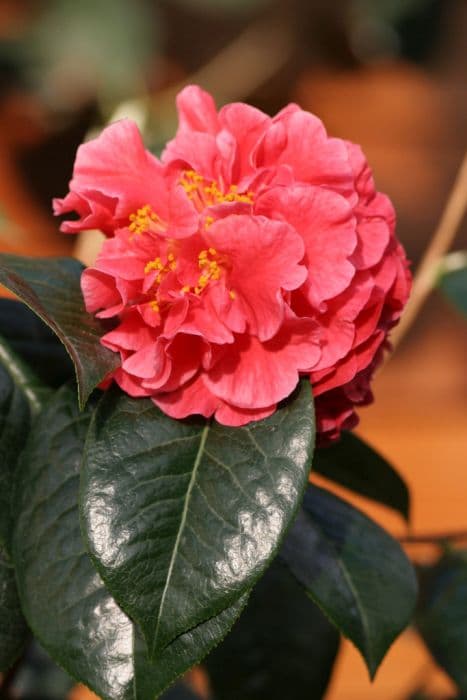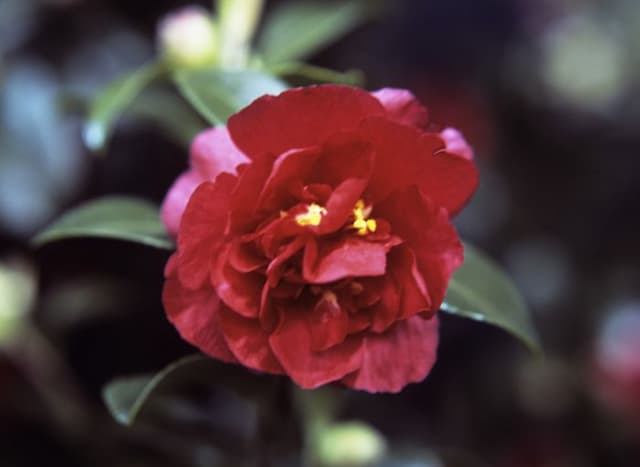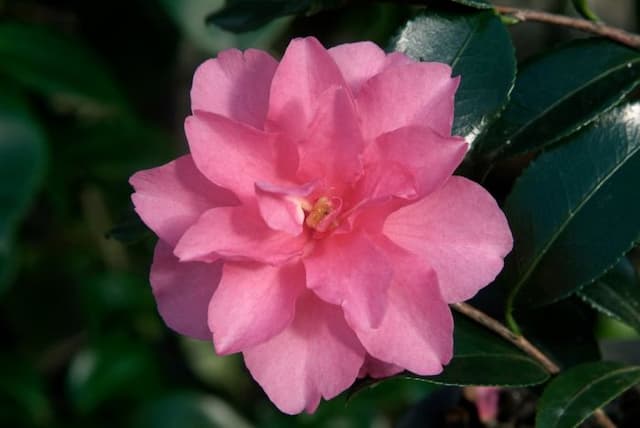Camellia Camellia × williamsii 'Gwavas'

ABOUT
The Camellia 'Gwavas' is a striking evergreen shrub known for its beautiful and delicate flowers. Its dark green, glossy leaves provide a perfect backdrop to the ornamental blooms. The flowers are typically a vibrant pink hue with a slightly paler edge, creating a soft and romantic appeal. They are large and showy, with a rounded shape and overlapping petals that form an intricate, peony-like pattern. Each blossom has a prominent central cluster of yellow stamens that add contrast and interest to the flower's appearance. The plant gives a lush, dense look, and its blooms stand out elegantly against the foliage, making it a favorite for gardens and as a decorative plant. The overall aesthetic of the Camellia 'Gwavas' is one of classic beauty, with blooms that can bring a splash of color to any setting during its flowering season.
About this plant
 Names
NamesFamily
Theaceae
Synonyms
Gwavas Camellia
Common names
Camellia × williamsii 'Gwavas'.
 Toxicity
ToxicityTo humans
The plant known as Williamsii Camellia is not known to be toxic to humans. There are no well-documented symptoms of poisoning from ingesting this plant because it is generally considered non-toxic to humans. However, as with any plant, individuals might have allergies or sensitivities that could cause a reaction, but this is not common.
To pets
Williamsii Camellia is also not considered toxic to pets. This means that ingestion of the leaves, flowers, or any other part of the plant typically does not lead to poisoning in animals such as dogs and cats. Nonetheless, ingestion of non-food items can sometimes cause gastrointestinal upset in pets, so it is generally advised to prevent pets from eating plants not intended for consumption.
 Characteristics
CharacteristicsLife cycle
Perennials
Foliage type
Evergreen
Color of leaves
Green
Flower color
Pink
Height
6-8 feet (1.8-2.4 meters)
Spread
6-8 feet (1.8-2.4 meters)
Plant type
Shrub
Hardiness zones
7
Native area
Asia
Benefits
 General Benefits
General Benefits- Ornamental Value: The Williamsii Camellia features attractive flowers, which add beauty to gardens and landscapes.
- Year-Round Interest: With glossy evergreen leaves and winter-to-spring blooming flowers, it provides visual interest throughout the year.
- Shade Tolerance: This camellia variety can thrive in semi-shaded areas, making it suitable for woodland or sheltered garden settings.
- Variety of Colors: The flowers come in different shades, including pinks and whites, allowing for a range of color schemes in garden design.
- Drought Resistance: Once established, Camellia × williamsii 'Gwavas' exhibits a degree of drought resistance, reducing the need for frequent watering.
- Low Maintenance: Generally, it requires minimal pruning and care once established, making it a good choice for gardeners seeking low-maintenance plants.
- Wildlife Attraction: The flowers can attract pollinators such as bees to the garden, supporting local ecosystems.
 Medical Properties
Medical PropertiesThis plant is not used for medical purposes.
 Air-purifying Qualities
Air-purifying QualitiesThis plant is not specifically known for air purifying qualities.
 Other Uses
Other Uses- Camellia × williamsii 'Gwavas' can be used in bonsai cultivation due to its attractive foliage and flowers, offering a challenge to enthusiasts of the art form.
- The petals of the camellia can be used to add a decorative touch to salads or as an edible garnish, though they should be free of pesticides and confirmed safe for consumption.
- The fallen blooms of camellias can create a natural carpet of color beneath the plant, providing a visually pleasing aspect to a garden without additional effort.
- These plants can be grown in large containers to adorn patios and balconies, where garden space may be limited.
- Crafters sometimes use the leaves and dried flowers in creating botanical jewelry, such as resin pendants or earrings.
- The thick foliage provides shelter for wildlife, such as birds, who may nest among the branches or use the plant as a protective cover.
- The wood of camellia, when pruned, can be used in woodworking for crafting small objects or for turning on a lathe due to its fine grain.
- Camellia × williamsii 'Gwavas' can be used in cut flower arrangements, with their blooms adding elegance and color to various floral designs.
- These plants can act as living fences or privacy screens, given their dense growing habit when planted in a row.
- Photographers and artists may use the camellia as a subject due to its beautiful blooms and the way it symbolizes the transition from winter to spring.
Interesting Facts
 Feng Shui
Feng ShuiThe Camellia is not used in Feng Shui practice.
 Zodiac Sign Compitability
Zodiac Sign CompitabilityThe Camellia is not used in astrology practice.
 Plant Symbolism
Plant Symbolism- Adoration: Camellias represent adoration. This can be attributed to their perfect, lush petals and long-lasting blooms which symbolize the enduring nature of love.
- Devotion: The long blooming season of the camellia stands for the steadfastness and devotion one holds for another.
- Perfection: With its immaculate flower form, camellias symbolize the ideal or perfection, often being gifted as a compliment to someone's impeccable qualities.
- Longevity: Camellias are evergreen and have a long blooming period, making them a symbol of longevity and everlasting life.
- Beauty: Camellias are often associated with beauty due to their attractive flowers and have been celebrated in Asian art and culture for this trait.
 Water
WaterWilliamsii camellias require consistent moisture for optimal growth, but overwatering can lead to root rot. During the growing season in spring and summer, water once a week with about 1 to 1.5 gallons of water. Ensure the topsoil becomes slightly dry between watering sessions but is never completely dry. Decrease watering to every two to three weeks in the fall and winter when the plant is not actively growing. Adjust watering frequency based on rainfall, less if there's a lot of rain, and more during dry spells.
 Light
LightWilliamsii camellias thrive in partial shade to filtered sunlight, protected from the intense midday sun. A spot that receives morning light and afternoon shade is ideal, as the direct afternoon sun can scorch the leaves. If indoors, place the plant near a window with bright, indirect light to avoid leaf burn while providing sufficient light for flowering and growth.
 Temperature
TemperatureWilliamsii camellias prefer moderate temperatures and are hardy within a range of 20°F to 85°F. They can survive brief drops to around 10°F, but prolonged exposure can damage the plant. The ideal temperature range is between 60°F and 75°F, which encourages healthy growth and flowering. Protect from extreme temperature fluctuations and cold drafts.
 Pruning
PruningPrune Williamsii camellias to maintain their shape and encourage airflow, which helps prevent diseases. The best time for pruning is just after the blooming season ends, usually in late winter or early spring. Remove dead or weak branches, and thin out dense areas, but do so sparingly as camellias do not require heavy pruning. Prune every year or every other year depending on the plant's appearance and health.
 Cleaning
CleaningAs needed
 Soil
SoilWilliamsii Camellia thrives in well-draining, acidic soil with a pH between 5.0 and 6.5. A mix containing peat, pine bark, and perlite in equal parts can create an ideal growing medium that allows for proper moisture retention and aeration.
 Repotting
RepottingWilliamsii Camellia should be repotted every 2-3 years or when the root system outgrows the current pot, typically in the late winter or early spring before new growth starts.
 Humidity & Misting
Humidity & MistingWilliamsii Camellia prefers a humid environment with humidity levels ranging between 40-60%, which can often be achieved in a natural outdoor setting or indoors with the help of a humidifier.
 Suitable locations
Suitable locationsIndoor
Ensure bright, indirect light, acidic soil, and maintain high humidity.
Outdoor
Plant in partial shade, acidic soil, protect from cold winds.
Hardiness zone
7-9 USDA
 Life cycle
Life cycleCamellia × williamsii 'Gwavas', commonly known as Williamsii Camellia, begins its life cycle when the seeds are sown or more typically when cuttings are taken from a mature plant. The cuttings then develop roots and grow into young plants, which can take several weeks to months. Once the plants are established and have formed a solid root system, they enter a vegetative growth phase, producing glossy, evergreen leaves. After a few years, the Williamsii Camellia matures and starts to flower, typically during the late winter to early spring, showcasing large, showy flowers that can be various hues, depending on the cultivar. The flowers eventually give way to seed pods, although many gardeners propagate the plant through cuttings rather than seeds. As an evergreen, the Williamsii Camellia maintains its leaves throughout the year and can live for many years, even decades, with proper care and conditions.
 Propogation
PropogationPropogation time
Spring-Early Summer
The most popular method for propagating Camellia × williamsii 'Gwavas', commonly known as Japonica or Japanese camellia, is through semi-hardwood cuttings. This technique is typically carried out during the late summer or early fall when the new growth has begun to mature and harden slightly. Cuttings should be about 4 to 6 inches (10 to 15 centimeters) long and include several sets of leaves. The lower leaves are removed, and the cut end is dipped in rooting hormone before being inserted into a mix of moistened soilless potting mix and perlite or sand. The cuttings should then be placed in a sheltered, warm location with high humidity, ensuring that the soil remains moist but not waterlogged. A plastic cover or mini greenhouse can help maintain the desired conditions. Roots generally develop within a few months, after which the propagated camellias can be transplanted into individual pots or directly into the garden.









